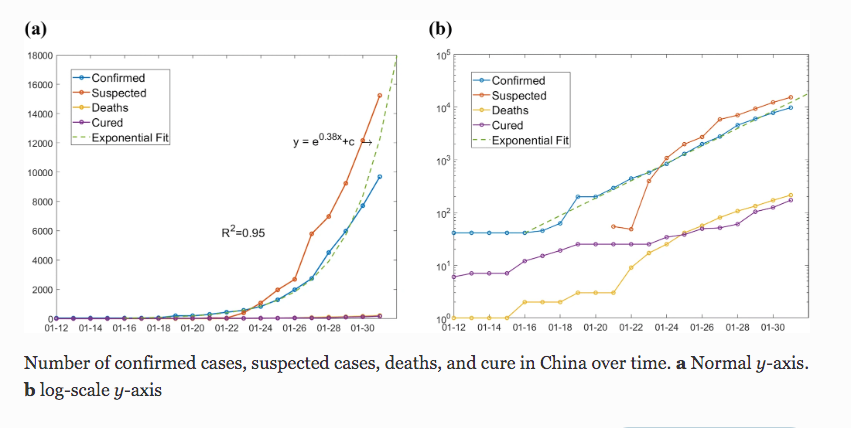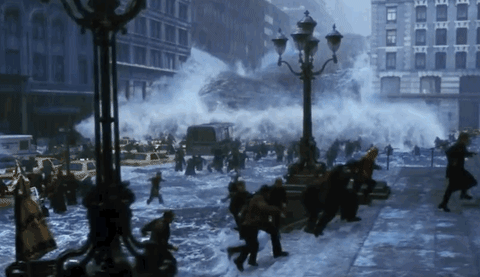Model Shows Coronavirus Spread Was “Exponential”

The Novel coronavirus (2019-nCoV) was spreading at an “exponential rate” doubling every 1.8 days in January, but new quarantine measures imposed in China may be slowing the pace of infection.
Research published in the journal Infection showed that 2019-nCoV had gained steam at the beginning of the year prior to health care and government officials realizing the scope of the outbreak.
Using a single-term exponential model, we yielded a high R2 value of 0.95. The exponent is 0.38, meaning that the infected population doubles in size around every 1.8 days. A divergence from the exponential fit is observed at the data point on the 31st January 2020, and we expect further divergence in the future, due to the effect of the new quarantine measures starting to take place.
The paper added that growth rate is “significantly different” from the doubling time estimated by several researchers in January, but this may have due to several factors, such as lack of awareness for the disease and lack of detection methods would have “hindered the disease detection and confirmation.”
“Day After Tomorrow” Villain Needs Better Modeling

Models used to measure changes in the Atlantic Meridional Overturning Circulation (AMOC) are falling short and there is a growing debate regarding the best way to follow the crucial oceanic system.
The AMOC was the meteorological culprit in the disaster film “Day After Tomorrow” and in reality is a crucial atmospheric and thermohaline driver.
According to a report in Wired, researchers find that current climate models are insufficient when trying to simulate small-scale ocean processes, such as “eddies” that are crucial to understanding the AMOC.
Martha Buckley, a climate scientist at George Mason University, says it’s mainly a problem of scale. “Certain ocean processes cannot be explicitly represented by models due to resolution constraints,” she says.
An underlying issue is that the ability to measure what’s happening in the ocean—not simulate it—has been extremely limited. “Observations of the AMOC are sparse, and scientific knowledge is mainly based on model simulations,” wrote Monika Rhein, a scientist at the University of Bremen, in Germany, in the journal Science last year.
To answer the shortfall, researchers are pushing for increased use of sensor-based instruments that can monitor the ocean floor and feed the models more accurate data.
Modelers are even starting to incorporate ocean data into their models nearly in real-time. This particular technique, known as ocean reanalysis, is “what atmospheric scientists have been doing for years in weather forecasting,” says Holliday, but ocean observers lacked the data to follow suit. “It keeps models closer to reality as they’re running.”
Insurers Harden Stance Against Wildfire Proposal
A proposal to require that insurers provide wildfire cover to California homeowners in return for “fire-hardening” their homes received immediate pushback from the private market.
According to a press release the California Insurance Commissoner Ricardo Lara, the Renew California bill (AB 2367) would require insurance companies to cover all existing homes as long as they meet new safety standards and would require insurance companies to offer “financial incentives” for homeowners that harden their homes.
Amy Bach, executive director of consumer advocacy group United Policyholders said in a statement announcing the bill:
"Three years ago when insurers started dropping homeowners in rural counties and hitting them with up to 500% price increases, UP issued a call for California to follow the lead of Florida, Alabama and South Carolina and create a risk reduction and insurance reward program. Now the problem has spread throughout the state and insurers won't come to the table voluntarily.
The president of the Rex Frazier, president of the Personal Insurance Federation of California, Rex Frazier, told the Los Angles Times that the proposed changes are no guarantee of reduced losses.
“We’re trying to figure out what is within the individual’s and the community’s power to stop property loss,” he said. “For wildfire, there’s no science right now that exists that can reliably predict what demonstrably reduces the risks of a homeowner. We’re not talking about ordinary home fires; we’re talking about mega-events. Even homes built to the 2008 standards in Paradise, only 50% of those homes survived.”





